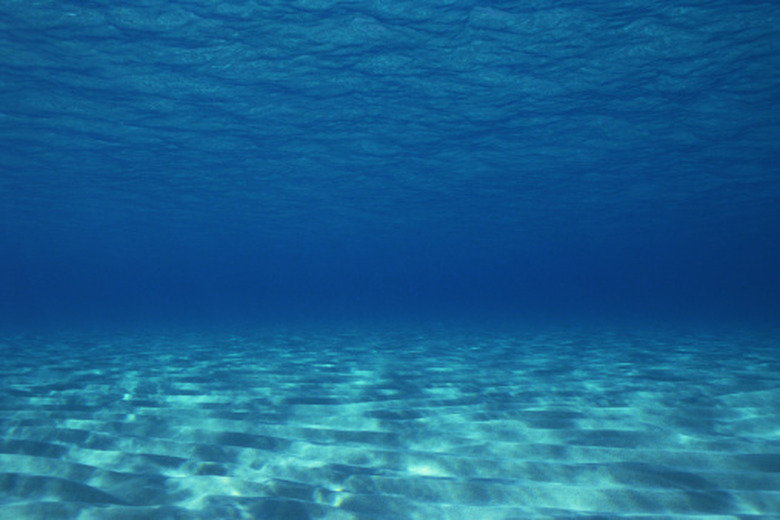The Types Of Seafloor Sediments
Before World War II, most people thought the ocean floor was the oldest and probably most boring place on Earth. After all, nothing happened except dirt and dead organisms piling up, right? During WWII the newly developed and top-secret technology of SONAR (short for _SO_und _NA_vigation and _R_anging) showed that the ocean floor wasn't boring after all; even the dirt is interesting. The ocean floor actually consists of different kinds of sediments, each with its own special characteristics.
TL;DR (Too Long; Didn't Read)
Seafloor sediment consist mostly of terrigenous sediment, biogenous sediment and hydrogenous sediment. Terrigenous sediments form from sediments carried from the land into the ocean by water, wind or ice. Biogenous sediments contain at least 30 percent material from once-living marine organisms, especially plankton. Hydrogenous sediments form when dissolved minerals precipitate or solidify from seawater. Two other types of sediments, volcanogenous (from volcanoes) and cosmogenous (from space), sometimes are classified as terrigenous sediments.
Types of Seafloor Sediments
Types of Seafloor Sediments
Seafloor sediment (the correct term for "dirt") may be divided into categories based on the source and type of material. The three largest categories are terrigenous or land-based sediments, biogenic or life-derived sediments and hydrogenetic or chemically derived sediments. Materials from volcanic eruptions and particles from space are sometimes included as terrigenous materials and sometimes put in their own categories.
Terrigenous Sediment: Sediments From Land
Terrigenous Sediment: Sediments From Land
Terrigenous translates from "terra," meaning earth or land, and genous derives from the suffix -gen, meaning "that which produces." Terrigenous sediments are also known as lithogenous sediments (litho means "stone"). Most ocean sediments, especially near the shore, consist of terrigenous or lithogenous sediments. Types of rocks that form from terrigenous sediments include sandstones, mudstones and shales.
Terrigenous sediments begin forming when erosion breaks apart rocks on land. Water, wind or sometimes ice carries these particles of rocks, or sediments, away from their source. The larger sediments take more energy to move, so they don't usually travel far, but erosion continues to work to break them down into smaller particles. Smaller sediments take less energy to move, so they travel much farther. Eventually most of these terrigenous sediments arrive in the ocean.
Rivers and streams carry most sediments into the ocean, where the sediments settle out as the force of water decreases. Larger rocks usually deposit close to the shore, but underwater landslides sometimes carry these larger sediments much farther out onto the ocean floor. Ocean currents carry smaller silt and clay particles many miles, with the smallest particles eventually forming the abyssal clay or red clay layer in the deep ocean.
While flowing water moves the vast majority of terrigenous sediments, ice and wind carry some sediments to the ocean. Ice in the form of glaciers pushes sediments in front and beneath their mass. Glaciers also carry sediments frozen within the ice. When glaciers reach the sea, the sediments fall into the ocean as the ice melts. Glaciers sometimes move very large boulders much farther than most rivers can carry. Wind carries much smaller particles, carrying sand and dust far out to sea.
Biogenous Sediment: Sediments from Life
Biogenous Sediment: Sediments from Life
Biogenous (bio means "life" or "living") sediment forms from the remains of once-living organisms. If at least 30 percent of the seafloor sediment consists of biogenetic material, the sediment is classified as biogenous sediment. Since most of the biological remains come from microscopic or near-microscopic plankton, biogenous sediments sometimes are referred to as oozes. Examples of rocks formed from biogenous sediments include fossil reefs and most limestones.
Shells and similar remnants of ocean life compose biogenous sediment. The two most common materials in shells are calcium carbonate and silica. Some biogenous sediments form close to their source, like calcium carbonate deposits along reefs. Other biogenous sediments form as tiny shells sink to the bottom of the ocean. Because of differences in chemistry, seafloor sediments made of calcium carbonate most commonly form in shallower and warmer water. Seafloor sediments made of silica more often occur in deeper or colder water.
Most of these biological remains are consumed as part of the ocean's food chain or they dissolve as they sink. Only about 1 percent of these tiny shells reach the ocean bottom to form biogenous sediment. Despite this very small percentage, biogenous sediments comprise the second most common type of marine sediments.
Hydrogenous Sediment: Chemistry in Action
Hydrogenous Sediment: Chemistry in Action
Hydrogenous (hydro means "water") sediments occur when minerals precipitate, forming as a solid from a solution. These marine sediments form when seawater becomes oversaturated with minerals. A change in conditions, like a change in temperature or decrease in seawater volume, can increase the concentration of minerals beyond the capacity of the seawater to dissolve the mineral. For example, when seawater evaporates, salt and other minerals precipitate out. Other hydrogenous sediments form when boiling water containing minerals like manganese and iron from hydrothermal vents combine with colder seawater. The minerals come out of solution, or precipitate, as the hot water cools. Some hydrogenous sediments include halite (salt), chemical limestone and manganese nodules.
Other Types of Sediments
Other Types of Sediments
Volcanic eruptions release a variety of material, including lava flows, bombs and ash. Like any other material, these rocks may travel into the ocean. Wind in particular carries volcanic dust long distances. These volcanic materials may be included as lithogenous or terrigenous sediment but sometimes are placed in a category of their own called volcanogenous sediment.
Some dust and particles found as ocean sediments come from space. Space dust, asteroids and meteors form cosmogenous sediment. Cosmic dust sometimes forms particles called tektites, which contain high concentrations of iridium.
Cite This Article
MLA
Blaettler, Karen G. "The Types Of Seafloor Sediments" sciencing.com, https://www.sciencing.com/types-seafloor-sediments-8302535/. 16 July 2018.
APA
Blaettler, Karen G. (2018, July 16). The Types Of Seafloor Sediments. sciencing.com. Retrieved from https://www.sciencing.com/types-seafloor-sediments-8302535/
Chicago
Blaettler, Karen G. The Types Of Seafloor Sediments last modified March 24, 2022. https://www.sciencing.com/types-seafloor-sediments-8302535/
